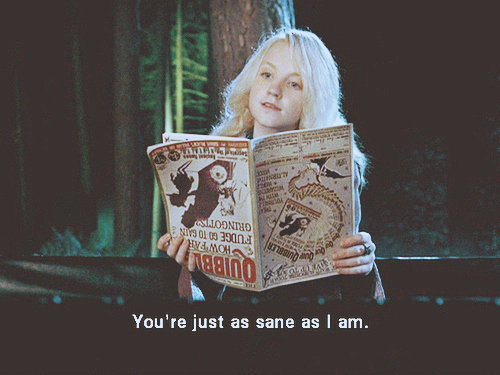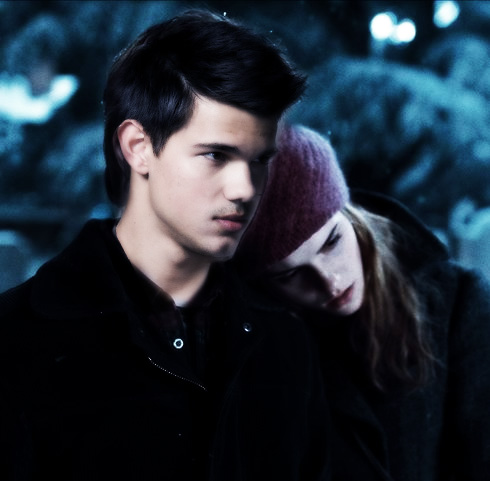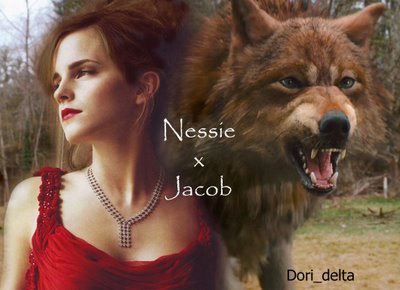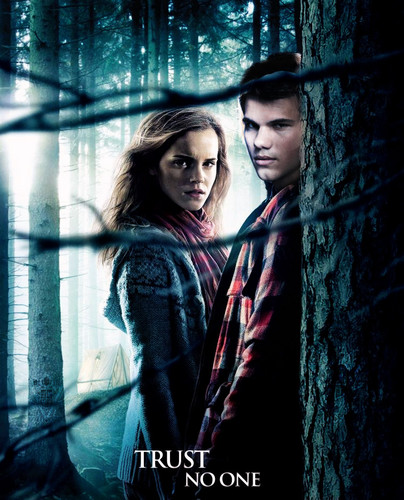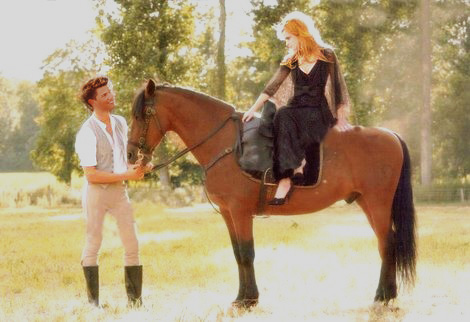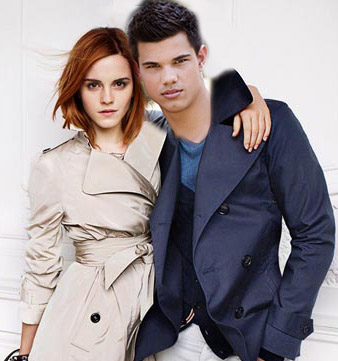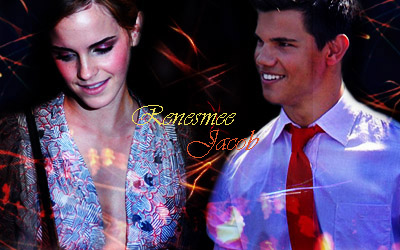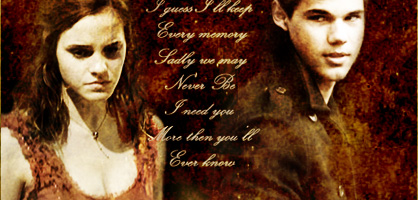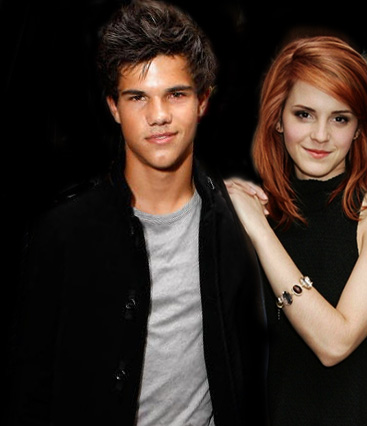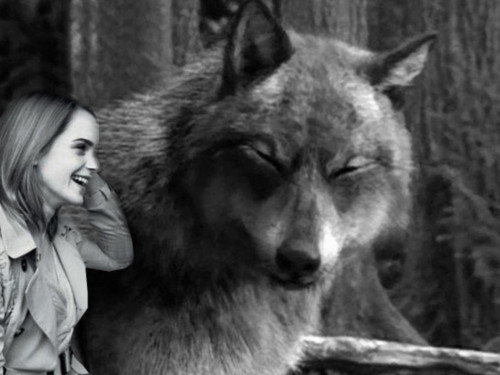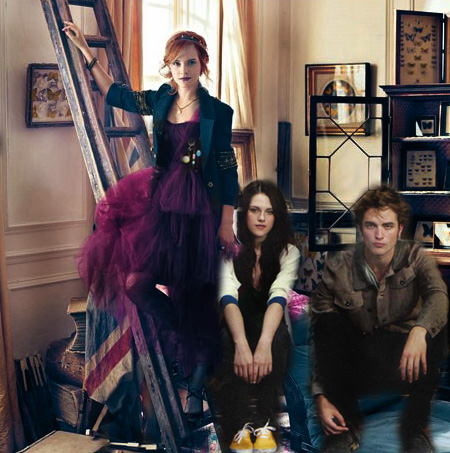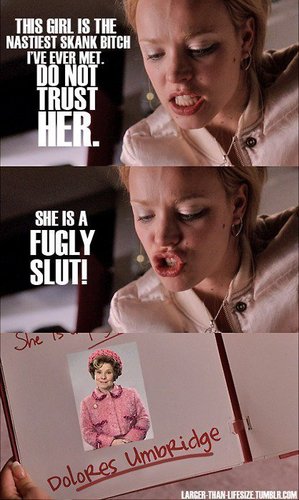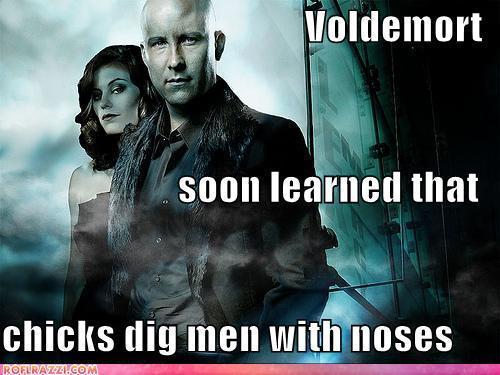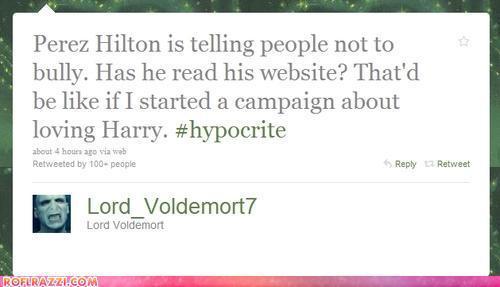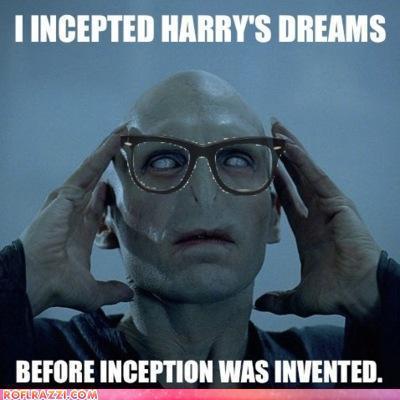Okay, my friend and I go to a school that has a thing called 'Lit Circles'. There's a list of books, and Twilight is on there, but not Harry Potter. My friend thought this was totally wrong, and wrote a super long persuasive essay to our English teacher about it. This was all hers, and I can't take credit for how awesome it is :)
Why Twilight Should Be Replaced by Harry Potter in Lit Circles
Two books sit on the shelf in front of you; on the cover of the first, you see two pale hands holding a deep red apple. The second features a young boy on a broomstick, in midair as he desperately chases a small, fluttering golden ball. Twilight, a simple 'love story', and Harry Potter, a thrilling tale of a man's struggle to end a war that's tearing his home apart, are two stories that are often compared and contrasted in today's society. Though the two book series are endlessly different, the die-hard fans in today's society often feud over if their favorite is better or not. Different variables, such as fans, writing, characters, and plots strongly affect the arguments of the 'Twi-hards' and the 'Potterheads'. However, it is apparent that Twilight is not up to the standards that our school boasts to uphold, and Harry Potter should replace it on the choices list for Literary Circles.
The most popular argument is that the characters in Twilight are well-rounded and dynamic, but that the favorites of Harry Potter, like Draco Malfoy and Luna Lovegood, are flat and commonplace. However, the characters of Twilight are unrealistic; Bella Swan, a self-conscious girl, somehow managed to become the prettiest, most popular girl in school on her first day. Edward Cullen is described as perfect, gorgeous, and a complete gentleman, and Stephenie Meyer fails to point out any character flaws. He's the 'Golden Boy', and he fails to change throughout the entire story. Rosalie Hale is the only character in the story worth while; she is the only one who shows deep emotion, and a tragic past has morphed her into a dynamic, interesting character. In Harry Potter, all the characters are well-rounded and riveting in their own way. For instance, Harry Potter, the main character, has quite a few flaws; he insists on working alone, and constantly tries to push the ones he loves away. He also has his positive attributes; he's brave (which is why he was placed in Gryffindor House), and he isn't in it for the glory; he fights for the greater good of his community, and even in the face of certain death (In the Forbidden Forest in Harry Potter and the Deathly Hallows), he chooses to rise to the challenges that lie ahead. His friends, Ron and Hermione, are also unique, yet realistic. Ron, for example, has a bit of an anger problem. In Harry Potter and the Goblet of Fire, he and Harry get into a fight because Ron is jealous that Harry got chosen as a Champion for Hogwarts. He accuses Harry of cheating, and gets angry when Harry denies it. Ron, too, has his positive qualities; he's a good Keeper, and he is undyingly loyal and brave. There really are no dull characters; they each have something that makes them stand out from the mundane, unlike the commonplace inhabitants of Meyer's version of Forks, Washington.
Another argument Twilight fans present is that Twilight contains a deeper emotional tone. However, Harry Potter evokes emotions of fans everywhere. Through Harry's eyes, we can feel and experience what he experiences; the loss of a mother, a father, a godfather, and a mentor. We can share the horror of watching people get hurt and die, some of them old, and some of them as young as sixteen years old (Collin Creevy). In Twilight, only three emotions are present; anger, romantic love, and parental love. Anger is hardly present in Twilight. Meyer shows small signs of it here and there; Edward growling at anyone who as much as looks at Bella, Bella throwing tiny, angry fits every time she doesn't get her way, and when Charlie thinks that Edward got Bella pregnant in Breaking Dawn. Parental love is hardly there, as well. Charlie is seen as gruff, and unwilling to portray emotion toward Bella, even in the happiest of times. In Breaking Dawn, when he starts to cry at Bella's wedding, he hides in the corner, unwilling to show his face. Renee, her emotional mother, is gone for most of the series and only shows up on very rare occasions. Romantic love is present almost too much; on almost every page, you see something about how gorgeous and wonderful and perfect Edward is.
In fact, Bella's feelings toward Edward are more obsessive. He consumes her every thought, and she can hardly breathe without Edward by her side. Some people say this is romantic, but it's borderline pathetic. Despite his obvious control issues and anger problems, Bella continues to think that he's the most amazing thing on the planet. She even turns her back on her friends, and though he coldly and emotionlessly left her alone and crying in the forest, she begs for him to take her back. She constantly defies and disrespects her father, just to get more time with Edward. In Harry Potter, Rowling's little cast of characters think for themselves, and the only time love like Edward's and Bella's is shown in Harry Potter is when Romilda Vane slips Ron a love potion, though it's intended or Harry. Slughorn says himself that Amortentia, the most powerful love potion in the world cannot produce real, genuine love, just potent obsession. Romantic love is still very present in Harry Potter; Rowling portrays couples perfectly. Ginny and Harry share a realistic relationship, and Ron and Hermione demonstrate the very common, very awkward feeling of falling in love with your best friend. Their relationships are something that all fans can relate to, not something for readers to fantasize and obsess over.
Another claim made by Twihards is that Meyer got her idea from a dream, a subconscious message, and that it makes it have a deeper meaning. Dreams show us our subconscious desires; perhaps at the time Meyer wanted a bit more romance in her life. However, Rowling was watching the rolling hills of Ireland and let her imagination wander. It took true creativity for Harry Potter to take shape, unlike Twilight. Also, Rowling's writing style is more advanced; Twilight is at a fourth grade reading level. Harry Potter, while ranked higher, can still be understood by a wide variety of ages. It also has deeper meaning. The only thing you wonder about in Twilight is who Bella will choose in the end, and even that was fairly obvious to all readers. In Harry Potter, you have to really think to come to conclusions. Will Harry defeat the Dark Lord in the end? Is Dumbledore actually dead, or did he just fake his death to get the upper hand on You-Know-Who and his Death Eater Army? Just exactly what side is Snape on? Will there ever be peace in the wizarding world? Harry Potter induces thinking, while Twilight just lets readers absorb information without getting in actual thought. Also, Twilight fans say that as Twilight is easier to read, more age groups can enjoy the novels. However, Rowling released a book of children stories, titled Tales of Beedle the Bard, in late 2008.
Also, Twilight has very elementary vocabulary. Harry Potter has an abundance of new words for students to learn, and it can even teach us a little bit about other countries outside of Northern America. In Twilight, you learn about a rainy town in Washington state that teaches you nothing about the rest of the world (I don't include Italy and the Volturi; you learn nothing of Italian culture or history); it stays restricted to the soggy little town. Harry Potter branches out to different parts of the globe. England, France, and Bulgaria are all mentioned in the books, and you can come out of the Harry Potter experience having learned some useful things.
Also, Twilight has a strong undercurrent of anti-feminism. In the books, Bella decides as a girl, it's her job to do all cooking and cleaning while her father sits on the couch, drinking beer and watching sports. This gives the impression that the place for a woman is the kitchen, and women have fought hard throughout history to repress such anti-feminist attitudes, and unfortunately, Twilight is a perfect example of the repression we woman experience daily, despite the fact that we are equals and have rights. Also, Edward controls every aspect of Bella's life, and therefore Twilight teaches girls to let men abuse and dominate them in the relationship. In today's society, women are already extremely repressed; a woman makes seventy cents to every dollar a man makes. We really shouldn't allow Twilight; it's forcing us to step back from the immense progress we've been making over the years.
As well as all things mentioned prior, Twilight fans seem to think that the Twilight Saga has better villains. On the contrary; Harry Potter's villain, the infamous Voldemort, also known as 'You-Know-Who', has depth. You learn about his past, how he came to be, how he shed his former self in an attempt to escape a past he so truly despises. In Twilight, the original villain, James, has no background; the only reason he's bad is because he's bad. There's no back-story, no woeful tale that allows the readers to delve into the minds of the antagonists. You simply here he wants to hurt the protagonist; no reason why, no interesting, tragic past. The reader is supposed to simply assume that he's just bad, without even getting the full story. The Volturi are a power-hungry clan of vampires that hide behind their cronies' gifts, showing an immense amount of cowardice. Victoria is a revenge-driven murderer, and perhaps the only semi-villainous character in the series.
Twilight also teaches young adults that using others for personal gain is okay. In New Moon, after Edward leaves, Bella is crushed. Her intense obsession with Edward is unhealthy, and when he's gone, she suffers from massive withdrawal. To get over her pain, she turns to Jacob Black, a boy from an Indian reserve not to far from Bella's home in Forks. After spending time with him, Bella notices that the presence of a boy in her life is comforting, and uses him almost like morphine; just something to numb the pain. After a while, Jacob develops a love for her, and Bella, instead of letting him down gently and giving him distance to ease the pain, continues to use him to get rid of her loneliness. This, too, shows a tone of anti-feminism. Bella seems to think that the only way to be happy in life is to have the company of a man. Instead of being strong and independent, a good role model, Meyer decides to have Bella desperately cling to any boy she can get her hands on. This does not set a good example for the multitude of impressionable teens at our school. In Harry Potter, you see plenty of good, strong female characters; Hermione, Luna, Ginny, and Molly Weasley, to name a few. They all show strong examples of feminism. For instance, Hermione deals with the constant teasing and name-calling by the Slytherins, but she just holds her head high and doesn't let the opinion of others affect her everyday life. That is just one of the many ways that Harry Potter teaches young adults to be confident and sure in themselves.
In addition, the argument of first person point of view versus third person point of view. While both writing styles work well, in first person, you only really learn about the feelings and emotions of the protagonist. In third person, you get to see more of the other characters, learn of other things going on in the story. You can stray away from the main character for a moment and see what other events, significant or not, that can affect the plot. For example, in Harry Potter and the Half-Blood Prince, you see a scene that doesn't include Harry. He is mentioned, but he does not ever make an appearance; you get to see what things are going on outside the narrator's life at the moment in time. In Twilight, Meyer had to completely change point of views halfway through Breaking Dawn, which can often confuse the reader at first. Rowling doesn't make this befuddling move.
Lastly, Rowling makes the books much more realistic in a lot of aspects. In Harry Potter, you can experience the harsh realities of prejudice, death, and war. In Twilight, Stephenie creates a sugar-coated world of happiness and unfortunately, ignorance. In every book, Bella faces a war, yet despite the constant danger and feuding; nobody dies, or even gets very hurt. In Harry Potter, readers and characters experience the crushing, though realistic blow, of their favorite characters dying; Sirius Black, Albus Dumbledore, and Lily and James Potter all fall at the hand of the antagonists, and they're just a few out of many. Also, in the wizarding world, we find a startling amount of discrimination and prejudice. The Pure bloods use slander and harsh words against muggle-borns (called Mudbloods) and pure-blood families who affiliate with them ('blood-traitors'). Also, most of the wizarding world looks down on other magical creatures, like centaurs, giants, and werewolves. For example, Remus Lupin is forced to resign simply because he's a werewolf (Harry Potter and the Prisoner of Azkaban). This bares a remarkable resemblance to reality, and teaches readers more about the world around them. However, at the end of the last book, Bella is sitting on the couch with her family, thinking about how wonderful it is that despite the Volturi's death march to Forks, they all managed to stay alive (Breaking Dawn). Even when an army of powerful vampires bent on destroying the Cullens come to Washington, Bella says a few things, and as if be magic, the Cullens are safe and everyone is safe and sound. This isn't how reality works, and to teach kids otherwise is wrong.
Twilight is a bad influence on us impressionable teens, while Harry Potter teaches us that confidence and bravery get you far in life. We should ban books that have negative affects on the youth of America and support books with good themes and messages. Together, as a nation, we can shape a better, more confident generation.
Works Cited
Meyer, Stephenie. Twilight. Boston: Little, Brown Young Readers, 2006.
Meyer, Stephenie. New Moon. Boston: Little, Brown Young Readers, 2006.
Meyer, Stephenie. Eclipse. Boston: Little, Brown Young Readers, 2007.
Meyer, Stephenie. Breaking Dawn. Boston: Little, Brown Young Readers, 2008.
Rowling, J.K. Harry Potter and the Sorcerers Stone. New York: Scholastic Inc., 1998.
Rowling, J.K. Harry Potter and the Chamber of Secrets. New York: Scholastic Inc., 1999.
Rowling, J.K. Harry Potter and the Prisoner of Azkaban. New York: Scholastic Inc., 1999.
Rowling, J.K. Harry Potter and the Goblet of Fire. New York: Scholastic Inc., 2000.
Rowling, J.K. Harry Potter and the Order of the Phoenix. New York: Scholastic Inc., 2003.
Rowling, J.K. Harry Potter and the Half-Blood Prince. New York: Scholastic, Inc., 2005.
Rowling, J.K. Harry Potter and the Deathly Hallows. New York: Scholastic Inc., 2007.
Rowling, J.K. The Tales of Beedle the Bard. New York: Scholastic Inc., 2008.
Why Twilight Should Be Replaced by Harry Potter in Lit Circles
Two books sit on the shelf in front of you; on the cover of the first, you see two pale hands holding a deep red apple. The second features a young boy on a broomstick, in midair as he desperately chases a small, fluttering golden ball. Twilight, a simple 'love story', and Harry Potter, a thrilling tale of a man's struggle to end a war that's tearing his home apart, are two stories that are often compared and contrasted in today's society. Though the two book series are endlessly different, the die-hard fans in today's society often feud over if their favorite is better or not. Different variables, such as fans, writing, characters, and plots strongly affect the arguments of the 'Twi-hards' and the 'Potterheads'. However, it is apparent that Twilight is not up to the standards that our school boasts to uphold, and Harry Potter should replace it on the choices list for Literary Circles.
The most popular argument is that the characters in Twilight are well-rounded and dynamic, but that the favorites of Harry Potter, like Draco Malfoy and Luna Lovegood, are flat and commonplace. However, the characters of Twilight are unrealistic; Bella Swan, a self-conscious girl, somehow managed to become the prettiest, most popular girl in school on her first day. Edward Cullen is described as perfect, gorgeous, and a complete gentleman, and Stephenie Meyer fails to point out any character flaws. He's the 'Golden Boy', and he fails to change throughout the entire story. Rosalie Hale is the only character in the story worth while; she is the only one who shows deep emotion, and a tragic past has morphed her into a dynamic, interesting character. In Harry Potter, all the characters are well-rounded and riveting in their own way. For instance, Harry Potter, the main character, has quite a few flaws; he insists on working alone, and constantly tries to push the ones he loves away. He also has his positive attributes; he's brave (which is why he was placed in Gryffindor House), and he isn't in it for the glory; he fights for the greater good of his community, and even in the face of certain death (In the Forbidden Forest in Harry Potter and the Deathly Hallows), he chooses to rise to the challenges that lie ahead. His friends, Ron and Hermione, are also unique, yet realistic. Ron, for example, has a bit of an anger problem. In Harry Potter and the Goblet of Fire, he and Harry get into a fight because Ron is jealous that Harry got chosen as a Champion for Hogwarts. He accuses Harry of cheating, and gets angry when Harry denies it. Ron, too, has his positive qualities; he's a good Keeper, and he is undyingly loyal and brave. There really are no dull characters; they each have something that makes them stand out from the mundane, unlike the commonplace inhabitants of Meyer's version of Forks, Washington.
Another argument Twilight fans present is that Twilight contains a deeper emotional tone. However, Harry Potter evokes emotions of fans everywhere. Through Harry's eyes, we can feel and experience what he experiences; the loss of a mother, a father, a godfather, and a mentor. We can share the horror of watching people get hurt and die, some of them old, and some of them as young as sixteen years old (Collin Creevy). In Twilight, only three emotions are present; anger, romantic love, and parental love. Anger is hardly present in Twilight. Meyer shows small signs of it here and there; Edward growling at anyone who as much as looks at Bella, Bella throwing tiny, angry fits every time she doesn't get her way, and when Charlie thinks that Edward got Bella pregnant in Breaking Dawn. Parental love is hardly there, as well. Charlie is seen as gruff, and unwilling to portray emotion toward Bella, even in the happiest of times. In Breaking Dawn, when he starts to cry at Bella's wedding, he hides in the corner, unwilling to show his face. Renee, her emotional mother, is gone for most of the series and only shows up on very rare occasions. Romantic love is present almost too much; on almost every page, you see something about how gorgeous and wonderful and perfect Edward is.
In fact, Bella's feelings toward Edward are more obsessive. He consumes her every thought, and she can hardly breathe without Edward by her side. Some people say this is romantic, but it's borderline pathetic. Despite his obvious control issues and anger problems, Bella continues to think that he's the most amazing thing on the planet. She even turns her back on her friends, and though he coldly and emotionlessly left her alone and crying in the forest, she begs for him to take her back. She constantly defies and disrespects her father, just to get more time with Edward. In Harry Potter, Rowling's little cast of characters think for themselves, and the only time love like Edward's and Bella's is shown in Harry Potter is when Romilda Vane slips Ron a love potion, though it's intended or Harry. Slughorn says himself that Amortentia, the most powerful love potion in the world cannot produce real, genuine love, just potent obsession. Romantic love is still very present in Harry Potter; Rowling portrays couples perfectly. Ginny and Harry share a realistic relationship, and Ron and Hermione demonstrate the very common, very awkward feeling of falling in love with your best friend. Their relationships are something that all fans can relate to, not something for readers to fantasize and obsess over.
Another claim made by Twihards is that Meyer got her idea from a dream, a subconscious message, and that it makes it have a deeper meaning. Dreams show us our subconscious desires; perhaps at the time Meyer wanted a bit more romance in her life. However, Rowling was watching the rolling hills of Ireland and let her imagination wander. It took true creativity for Harry Potter to take shape, unlike Twilight. Also, Rowling's writing style is more advanced; Twilight is at a fourth grade reading level. Harry Potter, while ranked higher, can still be understood by a wide variety of ages. It also has deeper meaning. The only thing you wonder about in Twilight is who Bella will choose in the end, and even that was fairly obvious to all readers. In Harry Potter, you have to really think to come to conclusions. Will Harry defeat the Dark Lord in the end? Is Dumbledore actually dead, or did he just fake his death to get the upper hand on You-Know-Who and his Death Eater Army? Just exactly what side is Snape on? Will there ever be peace in the wizarding world? Harry Potter induces thinking, while Twilight just lets readers absorb information without getting in actual thought. Also, Twilight fans say that as Twilight is easier to read, more age groups can enjoy the novels. However, Rowling released a book of children stories, titled Tales of Beedle the Bard, in late 2008.
Also, Twilight has very elementary vocabulary. Harry Potter has an abundance of new words for students to learn, and it can even teach us a little bit about other countries outside of Northern America. In Twilight, you learn about a rainy town in Washington state that teaches you nothing about the rest of the world (I don't include Italy and the Volturi; you learn nothing of Italian culture or history); it stays restricted to the soggy little town. Harry Potter branches out to different parts of the globe. England, France, and Bulgaria are all mentioned in the books, and you can come out of the Harry Potter experience having learned some useful things.
Also, Twilight has a strong undercurrent of anti-feminism. In the books, Bella decides as a girl, it's her job to do all cooking and cleaning while her father sits on the couch, drinking beer and watching sports. This gives the impression that the place for a woman is the kitchen, and women have fought hard throughout history to repress such anti-feminist attitudes, and unfortunately, Twilight is a perfect example of the repression we woman experience daily, despite the fact that we are equals and have rights. Also, Edward controls every aspect of Bella's life, and therefore Twilight teaches girls to let men abuse and dominate them in the relationship. In today's society, women are already extremely repressed; a woman makes seventy cents to every dollar a man makes. We really shouldn't allow Twilight; it's forcing us to step back from the immense progress we've been making over the years.
As well as all things mentioned prior, Twilight fans seem to think that the Twilight Saga has better villains. On the contrary; Harry Potter's villain, the infamous Voldemort, also known as 'You-Know-Who', has depth. You learn about his past, how he came to be, how he shed his former self in an attempt to escape a past he so truly despises. In Twilight, the original villain, James, has no background; the only reason he's bad is because he's bad. There's no back-story, no woeful tale that allows the readers to delve into the minds of the antagonists. You simply here he wants to hurt the protagonist; no reason why, no interesting, tragic past. The reader is supposed to simply assume that he's just bad, without even getting the full story. The Volturi are a power-hungry clan of vampires that hide behind their cronies' gifts, showing an immense amount of cowardice. Victoria is a revenge-driven murderer, and perhaps the only semi-villainous character in the series.
Twilight also teaches young adults that using others for personal gain is okay. In New Moon, after Edward leaves, Bella is crushed. Her intense obsession with Edward is unhealthy, and when he's gone, she suffers from massive withdrawal. To get over her pain, she turns to Jacob Black, a boy from an Indian reserve not to far from Bella's home in Forks. After spending time with him, Bella notices that the presence of a boy in her life is comforting, and uses him almost like morphine; just something to numb the pain. After a while, Jacob develops a love for her, and Bella, instead of letting him down gently and giving him distance to ease the pain, continues to use him to get rid of her loneliness. This, too, shows a tone of anti-feminism. Bella seems to think that the only way to be happy in life is to have the company of a man. Instead of being strong and independent, a good role model, Meyer decides to have Bella desperately cling to any boy she can get her hands on. This does not set a good example for the multitude of impressionable teens at our school. In Harry Potter, you see plenty of good, strong female characters; Hermione, Luna, Ginny, and Molly Weasley, to name a few. They all show strong examples of feminism. For instance, Hermione deals with the constant teasing and name-calling by the Slytherins, but she just holds her head high and doesn't let the opinion of others affect her everyday life. That is just one of the many ways that Harry Potter teaches young adults to be confident and sure in themselves.
In addition, the argument of first person point of view versus third person point of view. While both writing styles work well, in first person, you only really learn about the feelings and emotions of the protagonist. In third person, you get to see more of the other characters, learn of other things going on in the story. You can stray away from the main character for a moment and see what other events, significant or not, that can affect the plot. For example, in Harry Potter and the Half-Blood Prince, you see a scene that doesn't include Harry. He is mentioned, but he does not ever make an appearance; you get to see what things are going on outside the narrator's life at the moment in time. In Twilight, Meyer had to completely change point of views halfway through Breaking Dawn, which can often confuse the reader at first. Rowling doesn't make this befuddling move.
Lastly, Rowling makes the books much more realistic in a lot of aspects. In Harry Potter, you can experience the harsh realities of prejudice, death, and war. In Twilight, Stephenie creates a sugar-coated world of happiness and unfortunately, ignorance. In every book, Bella faces a war, yet despite the constant danger and feuding; nobody dies, or even gets very hurt. In Harry Potter, readers and characters experience the crushing, though realistic blow, of their favorite characters dying; Sirius Black, Albus Dumbledore, and Lily and James Potter all fall at the hand of the antagonists, and they're just a few out of many. Also, in the wizarding world, we find a startling amount of discrimination and prejudice. The Pure bloods use slander and harsh words against muggle-borns (called Mudbloods) and pure-blood families who affiliate with them ('blood-traitors'). Also, most of the wizarding world looks down on other magical creatures, like centaurs, giants, and werewolves. For example, Remus Lupin is forced to resign simply because he's a werewolf (Harry Potter and the Prisoner of Azkaban). This bares a remarkable resemblance to reality, and teaches readers more about the world around them. However, at the end of the last book, Bella is sitting on the couch with her family, thinking about how wonderful it is that despite the Volturi's death march to Forks, they all managed to stay alive (Breaking Dawn). Even when an army of powerful vampires bent on destroying the Cullens come to Washington, Bella says a few things, and as if be magic, the Cullens are safe and everyone is safe and sound. This isn't how reality works, and to teach kids otherwise is wrong.
Twilight is a bad influence on us impressionable teens, while Harry Potter teaches us that confidence and bravery get you far in life. We should ban books that have negative affects on the youth of America and support books with good themes and messages. Together, as a nation, we can shape a better, more confident generation.
Works Cited
Meyer, Stephenie. Twilight. Boston: Little, Brown Young Readers, 2006.
Meyer, Stephenie. New Moon. Boston: Little, Brown Young Readers, 2006.
Meyer, Stephenie. Eclipse. Boston: Little, Brown Young Readers, 2007.
Meyer, Stephenie. Breaking Dawn. Boston: Little, Brown Young Readers, 2008.
Rowling, J.K. Harry Potter and the Sorcerers Stone. New York: Scholastic Inc., 1998.
Rowling, J.K. Harry Potter and the Chamber of Secrets. New York: Scholastic Inc., 1999.
Rowling, J.K. Harry Potter and the Prisoner of Azkaban. New York: Scholastic Inc., 1999.
Rowling, J.K. Harry Potter and the Goblet of Fire. New York: Scholastic Inc., 2000.
Rowling, J.K. Harry Potter and the Order of the Phoenix. New York: Scholastic Inc., 2003.
Rowling, J.K. Harry Potter and the Half-Blood Prince. New York: Scholastic, Inc., 2005.
Rowling, J.K. Harry Potter and the Deathly Hallows. New York: Scholastic Inc., 2007.
Rowling, J.K. The Tales of Beedle the Bard. New York: Scholastic Inc., 2008.


